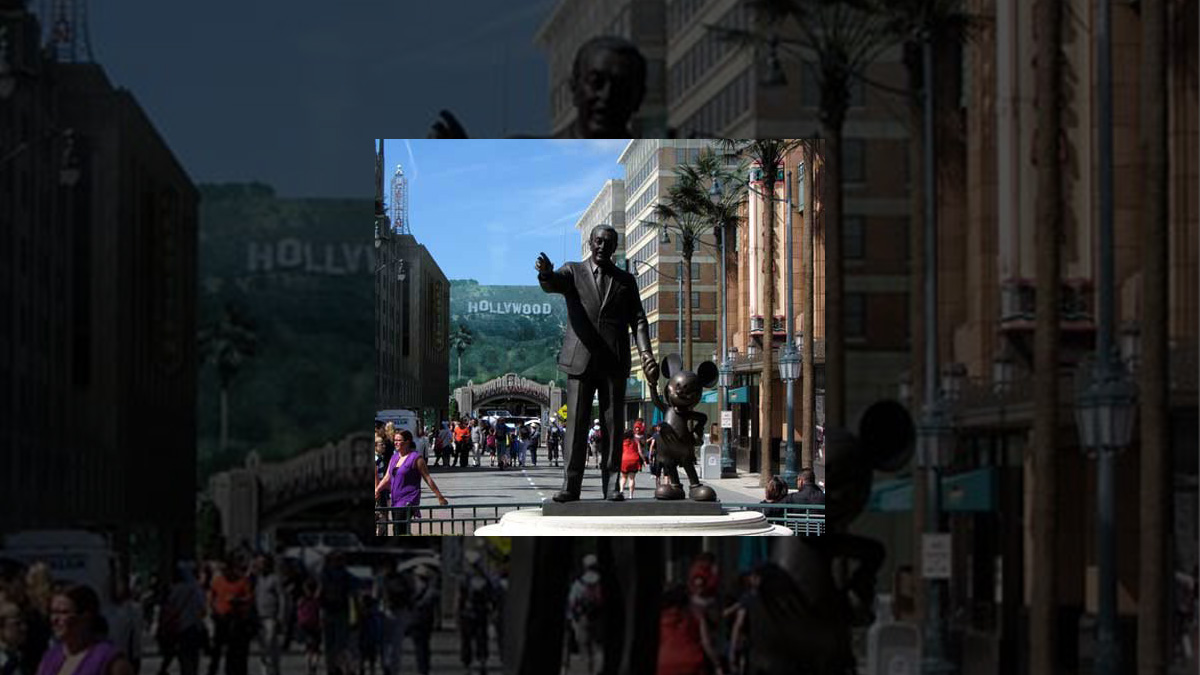
EuroDisney S.C.A. (i.e., the financial company behind
Disneyland Resort Paris) has a lot at stake with the opening of its brand-new
multimillion attraction, “Ratatouille, l’avventure totalement toque de Remy”
(which — for all of you English-speaking Disney fans out — translates into
“Remy’s Totally Crazy Adventure”).
It’s also worth noting here that the word “toque” in French
means both “crazy” but also stands for chef’s hat, “the toque.”…this is aclever summing up of how crazy the road to this attraction has been for
Disneyland Paris management and how much “ego” is also at play here.
As all Disneyland Paris watchers know, when Walt
Disney Studios Park
opened on the 16th of March 2002,
it had only 9 attractions and very weak theming. Though the Front Lot was and
is still regarded by some as stunning, once Guests exit Studio 1 – WDS’ covered
version of Main Street, U.S.A. — it was a commonly acknowledged joke that (given
the way the Partners statue was positioned in the main plaza of Walt Disney
Studios Park) even Walt was pointing the way out of this theme park.
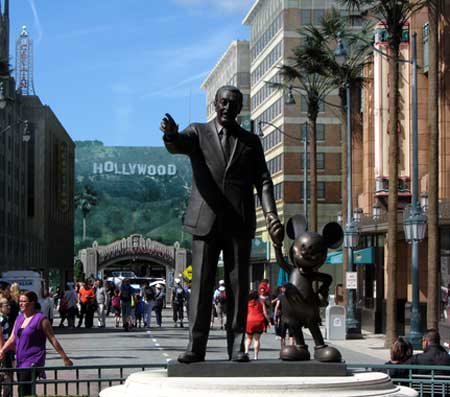
Walt Disney Studios was the last of a large expansion phase
which gave Walt Disney World its fourth gate (i.e, Disney’s Animal Kingdom.
Which has amazing theming but a low ride count), a second gate for the
Disneyland Resort (i.e., Disney’s California Adventure theme park. And we all
know how the original version of that project turned out), Tokyo
Disney SEAS
at the Tokyo Disney Resort (TDS is what many consider to be WDI’s modern
masterpiece) and a second gate for Disneyland Paris (which was originally supposed
to have been called “Disney-MGM Studios Europe”).
The low attendance of Walt Disney Studios (less then 3 million
guests in its first full year ) brought EuroDisney SCA back to its 1992-1996
“doom days” when the entire DLP resort struggled & had to make drastic cuts
to its operation line up and investments. This theme park simply wasn’t compelling
people to stay on property that extra night which would have then increased not
only ticket sales but also improved this resort’s restaurant revenues and hotel
bottom lines.
Disney Paris management quickly followed the Anaheim formula
and decided to clone the Tower of Terror ride into the park – this was to be
seen as a similar move to what was done in 1995 with the opening of “Space
Mountain” in Disneyland Park next door; a heavy investment attraction which was
to be a game changer for the park and with high marketing potential in Europe
(no other European park had such a highly themed thrill ride).
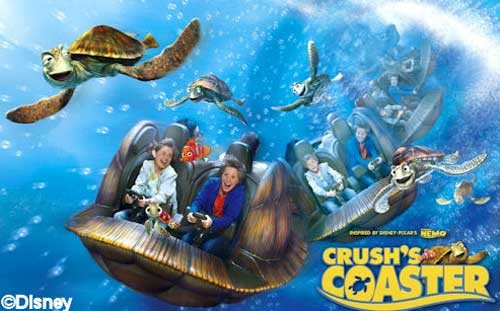
Along with the Tower came the “Toon Studios” area; with two
Pixar themed rides; the fun and thrilling “Crush’s Coaster” (a spinning
coaster-in-the-dark themed around the East Australian Current scene from
“Finding Nemo”) as well as a “Cars Race Rally” Cars themed spinner
ride.
These new rides allowed the park to establish itself as a
close-to-full day park; still closing at 6 p.m. in winter and 7 p.m. in summer
(but the park is often used for business or sponsor special events in Studio 1)
but still dragging in no more then 5.6 million Guests a year; thus being the
Cinderella of the Disney Parks & Resorts.
Walt Disney Company management finally decided to solve its
“Paris problem” once & for all by
dropped three large “gifts” onto the Resort.
 Copyright Disney Enterprises, Inc. All rights reserved
Copyright Disney Enterprises, Inc. All rights reserved
- the amazing “Disney DREAMS” nighttime show in 2012 for
Disneyland Paris’ 20th anniversary - it then paid back 1.5 billion Euros of debt the company had
owed the banks & lenders (out of 2.3 billion) and opened up a large play
area, “Toy Story Playland” in the Walt Disney Studios to up that theme’s ride count
as well as increase its overall kid-friendliness.
And this is where our story gets interesting.
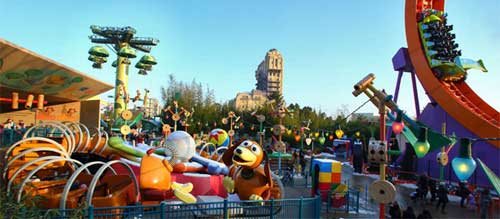 Copyright Disney Enterprises, Inc. All rights reserved
Copyright Disney Enterprises, Inc. All rights reserved
You see back in 2011 during the Toy Story Playland previews
guests got an amazing teaser of what Imagineering really wanted to do with thearea in the future. Which was open up an amazing Paris
street with a Ratatouille-based restaurant and ride.
During those annual passport & shareholder previews of
Toy Story Playland, Guests exited the area through a blue “barrel of fun” which
— on the other side — was an archway. And on top of this archway — for a
short few days, anyway — Guests would find a huge statue of Auguste Gusteau,
the chef from “Ratatouille.” And as they walked down this faux Parisian street,
Guests would find highly-themed benches with little chef Remys hidden in their
iron work. Which was a lot of theming & testing for an area which hadn’t even
been greenlit yet.
You see, Tom Fitzgerald — Executive Vice President of Walt
Disney Imagineering (More importantly, the man who was in charge of the
Disneyland Paris portfolio) — had delegated Tracy Eck (WDI’s operations head
for Paris) to have everything ready so that management could immediately greenlight
this cartoonish Paris-based area.
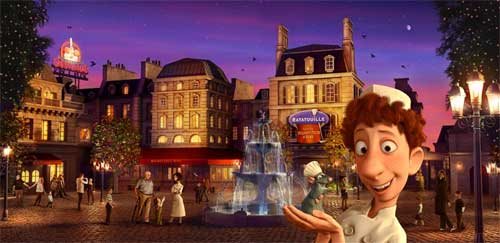 Copyright Disney Enterprises, Inc. All rights reserved
Copyright Disney Enterprises, Inc. All rights reserved
Imagineers knew that the Walt Disney Studios needed
something which could be sold to the French as “theirs” and yet familiar with
the Europeans. Tom also knew that the Studios lacked a true “themed area,”
one of those truly immersive place-making areas which Imagineering was famous
for. Fitzgerald’s team also knew that the Studios park didn’t have a truly
unique restaurant. Even worse, there was no proper sit-down restaurant (a must
for a theme park which wants to become a full-day destination).
It therefore was an obvious choice to create a highly themed
area, based on a truly French character who could then give this theme park amust-see attraction and — at the same time — justify the construction of a
fully functional sit-down restaurant.
Unfortunately, Disneyland Paris management couldn’t see its
way clear to greenlighting construction of this new area until the Walt Disney
Company waved that 1.5 Billion Euros (The Banks, up until then, had a very
strong say when it came how money was spent at that Park and didn’t want to
greenlight such a costly 150 million Euro reinvestment in the property).
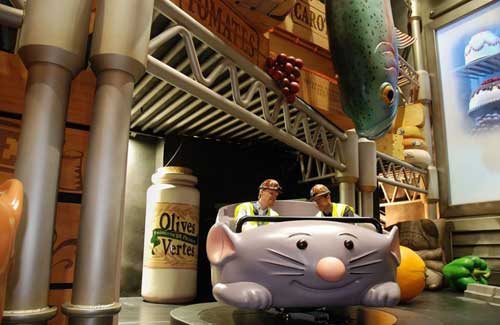 Copyright Disney Enterprises, Inc. All rights reserved
Copyright Disney Enterprises, Inc. All rights reserved
The wait though proved to be positive for Tom & Tracy
and their team as it allowed some rethinking of the ride system and show. When DLP
Guests finally venture into those Paris-themed show buidings which house the
ride they will board the result of 13 years of tweaking the most amazing ride
vehicle Imagineering has ever designed. “Ratatouille, l’avventure totalement
toque de Remy” uses a NextGen of Tokyo Disneyland’s “Pooh’s Hunny Hunt”
trackless ride vehicles (which debuted at that theme park back in 2001).
As they come through the queue, Guests will be shrunk down to
the size of a rat and then invited by Remy to come along with his friends
(which are rat-shaped ride vehicles) to travel along the rooftops of Paris and
then down into the kitchen where Chef Gusteau once worked and where Chef
Skinner now rules the roost.
And to really sell the idea that the Guests are now
rat-sized, everyone will be issued a set of 3D glasses before they board that
rat-shaped ride vehicle. And the combination of huge physical sets of kitchen
tools & refrigerators and giant 3D screens showing Skinner & Liguini
striding around this immense kitchen … Well, the end result is a NextGen
combination of Universal’s “The Amazing Adventures of Spider-Man”
& “Transformers : The Ride – 3D” with Disney’s “Pooh’s Hunny
Hunt” with a dash of Hong Kong Disneyland’s “Mystic Manor”
thrown in.
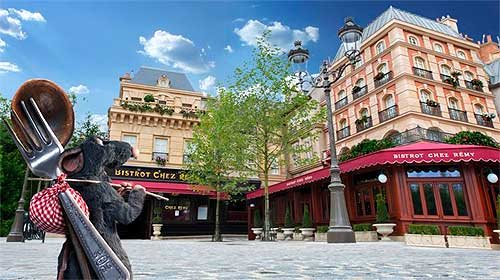 Copyright Disney Enterprises, Inc. All rights reserved
Copyright Disney Enterprises, Inc. All rights reserved
Once they’re out of Chef Skinner’s reach, Walt Disney Studios
Park Guests will no doubt want to sample the fare at “Bistrot Chez Remy.”
What makes this new sit-down restaurant fun is that — as Guests enter the
place — they’re still supposed to be the size of rats. Which is why — as they
dine — these people will be surrounded by huge plates, forks and knives. The
menu at Bistrot Chez Remy (which was tested last month at Disneyland Paris’s
Sequoia Lodge hotel) will offer pres et 3 course menu with the choice of 3 hors
d’ouvre, 3 main dishes and 3 desserts (including cheese as dessert) for a fixed
price. Which is something that is sure to be appreciated by DLP Guests,
especially given Europe’s current economic crunch. And
— of course — this being the “Bistro Chez Remy,” there has to be
Ratatouille on the menu.
It’s important to understand here that Walt Disney Imagineering
& Disneyland Paris both have a lot riding on “Ratatouille, l’avventure
totalement toque de Remy.” The July 10th opening of this Walt Disney Studios
Park addition (which comes on the heels of this past weekend’s media preview as
well as this ride’s upcoming annual passport & shareholder preview dates) (all to get as much word of mouth marketing
and publicity for this area as possible) will closely watched by senior Walt
Disney Company management. All with the hope that — should WDSP see a
significant uptick in attendance levels over the next six months — Disney may
decide to give this theme park a Disney California Adventure-like makeover.
Which would ultimately turn this theme into a full day experience with more
themed areas (there’s a plan to turn the Backlot into a Marvel-themed area) and
a nighttime show (which would mean the construction or a central lake/area to
stage this nighttime show on) or to just “Let It Go” when thinking about Paris.
And as for me … I plan on visiting Bistrot Chez Remy soon andeating some Ratatouille.
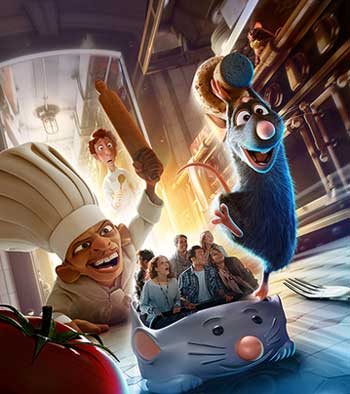 Copyright Disney Enterprises, Inc. All rights reserved
Copyright Disney Enterprises, Inc. All rights reserved
Salut mes amie!

History
The Evolution and History of Mickey’s ToonTown

Disneyland in Anaheim, California, holds a special place in the hearts of Disney fans worldwide, I mean heck, it’s where the magic began after all. Over the years it’s become a place that people visit in search of memorable experiences. One fan favorite area of the park is Mickey’s Toontown, a unique land that lets guests step right into the colorful, “Toony” world of Disney animation. With the recent reimagining of the land and the introduction of Micky and Minnies Runaway Railway, have you ever wondered how this land came to be?
There is a fascinating backstory of how Mickey’s Toontown came into existence. It’s a tale of strategic vision, the influence of Disney executives, and a commitment to meeting the needs of Disney’s valued guests.
The Beginning: Mickey’s Birthdayland
The story of Mickey’s Toontown starts with Mickey’s Birthdayland at Walt Disney World’s Magic Kingdom. Opened in 1988 to celebrate Mickey Mouse’s 60th birthday, this temporary attraction was met with such overwhelming popularity that it inspired Disney executives to think bigger. The idea was to create a permanent, immersive land where guests could step into the animated world of Mickey Mouse and his friends.
In the early ’90s, Disneyland was in need of a refresh. Michael Eisner, the visionary leader of The Walt Disney Company at the time, had an audacious idea: create a brand-new land in Disneyland that would celebrate Disney characters in a whole new way. This was the birth of Mickey’s Toontown.
Initially, Disney’s creative minds toyed with various concepts, including the idea of crafting a 100-Acre Woods or a land inspired by the Muppets. However, the turning point came when they considered the success of “Who Framed Roger Rabbit.” This film’s popularity and the desire to capitalize on contemporary trends set the stage for Toontown’s creation.
From Concept to Reality: The Birth of Toontown
In 1993, Mickey’s Toontown opened its gates at Disneyland, marking the first time in Disney Park history where guests could experience a fully realized, three-dimensional world of animation. This new land was not just a collection of attractions but a living, breathing community where Disney characters “lived,” worked, and played.
Building Challenges: Innovative Solutions
The design of Mickey’s Toontown broke new ground in theme park aesthetics. Imagineers were tasked with bringing the two-dimensional world of cartoons into a three-dimensional space. This led to the creation of over 2000 custom-built props and structures that embodied the ‘squash and stretch’ principle of animation, giving Toontown its distinctiveness.
And then there was also the challenge of hiding the Team Disney Anaheim building, which bore a striking resemblance to a giant hotdog. The Imagineers had to think creatively, using balloon tests and imaginative landscaping to seamlessly integrate Toontown into the larger park.

Key Attractions: Bringing Animation to Life
Mickey’s Toontown featured several groundbreaking attractions. “Roger Rabbit’s Car Toon Spin,” inspired by the movie “Who Framed Roger Rabbit,” became a staple of Toontown, offering an innovative ride experience. Gadget’s Go-Coaster, though initially conceived as a Rescue Rangers-themed ride, became a hit with younger visitors, proving that innovative design could create memorable experiences for all ages.
Another crown jewel of Toontown is Mickey’s House, a walkthrough attraction that allowed guests to explore the home of Mickey Mouse himself. This attraction was more than just a house; it was a carefully crafted piece of Disney lore. The house was designed in the American Craftsman style, reflecting the era when Mickey would have theoretically purchased his first home in Hollywood. The attention to detail was meticulous, with over 2000 hand-crafted, custom-built props, ensuring that every corner of the house was brimming with character and charm. Interestingly, the design of Mickey’s House was inspired by a real home in Wichita Falls, making it a unique blend of real-world inspiration and Disney magic.
Mickey’s House also showcased Disney’s commitment to creating interactive and engaging experiences. Guests could make themselves at home, sitting in Mickey’s chair, listening to the radio, and exploring the many mementos and references to Mickey’s animated adventures throughout the years. This approach to attraction design – where storytelling and interactivity merged seamlessly – was a defining characteristic of ToonTown’s success.

Executive Decisions: Shaping ToonTown’s Unique Attractions
The development of Mickey’s Toontown wasn’t just about creative imagination; it was significantly influenced by strategic decisions from Disney executives. One notable input came from Jeffrey Katzenberg, who suggested incorporating a Rescue Rangers-themed ride. This idea was a reflection of the broader Disney strategy to integrate popular contemporary characters and themes into the park, ensuring that the attractions remained relevant and engaging for visitors.
In addition to Katzenberg’s influence, Frank Wells, the then-President of The Walt Disney Company, played a key role in the strategic launch of Toontown’s attractions. His decision to delay the opening of “Roger Rabbit’s Car Toon Spin” until a year after Toontown’s debut was a calculated move. It was designed to maintain public interest in the park by offering new experiences over time, thereby giving guests more reasons to return to Disneyland.
These executive decisions highlight the careful planning and foresight that went into making Toontown a dynamic and continuously appealing part of Disneyland. By integrating current trends and strategically planning the rollout of attractions, Disney executives ensured that Toontown would not only capture the hearts of visitors upon its opening but would continue to draw them back for new experiences in the years to follow.
Global Influence: Toontown’s Worldwide Appeal
The concept of Mickey’s Toontown resonated so strongly that it was replicated at Tokyo Disneyland and influenced elements in Disneyland Paris and Hong Kong Disneyland. Each park’s version of Toontown maintained the core essence of the original while adapting to its cultural and logistical environment.
Evolution and Reimagining: Toontown Today
As we approach the present day, Mickey’s Toontown has recently undergone a significant reimagining to welcome “Mickey & Minnie’s Runaway Railway” in 2023. This refurbishment aimed to enhance the land’s interactivity and appeal to a new generation of Disney fans, all while retaining the charm that has made ToonTown a beloved destination for nearly three decades.

Dive Deeper into ToonTown’s Story
Want to know more about Mickey’s Toontown and hear some fascinating behind-the-scenes stories, then check out the latest episode of Disney Unpacked on Patreon @JimHillMedia. In this episode, the main Imagineer who worked on the Toontown project shares lots of interesting stories and details that you can’t find anywhere else. It’s full of great information and fun facts, so be sure to give it a listen!
History
Unpacking the History of the Pixar Place Hotel

Pixar Place Hotel, the newly unveiled 15-story tower at the Disneyland Resort, has been making waves in the Disney community. With its unique Pixar-themed design, it promises to be a favorite among visitors.
However, before we delve into this exciting addition to the Disneyland Resort, let’s take a look at the fascinating history of this remarkable hotel.
The Emergence of the Disneyland Hotel
To truly appreciate the story of the Pixar Place Hotel, we must turn back the clock to the early days of Disneyland. While Walt Disney had the visionary ideas and funding to create the iconic theme park, he faced a challenge when it came to providing accommodations for the park’s visitors. This is where his friend Jack Wrather enters the picture.
Jack Wrather, a fellow pioneer in the television industry, stepped in to assist Walt Disney in realizing his dream. Thanks to the success of the “Lassie” TV show produced by Wrather’s company, he had the financial means to build a hotel right across from Disneyland.
The result was the Disneyland Hotel, which opened its doors in October 1955. Interestingly, the early incarnation of this hotel had more of a motel feel than a hotel, with two-story buildings reminiscent of the roadside motels popular during the 1950s. The initial Disneyland Hotel consisted of modest structures that catered to visitors looking for affordable lodging close to the park. While the rooms were basic, it marked the beginning of something extraordinary.
The Evolution: From Emerald of Anaheim to Paradise Pier
As Disneyland’s popularity continued to soar, so did the demand for expansion and improved accommodations. In 1962, the addition of an 11-story tower transformed the Disneyland Hotel, marking a significant transition from a motel to a full-fledged hotel.
The addition of the 11-story tower elevated the Disneyland Hotel into a more prominent presence on the Anaheim skyline. At the time, it was the tallest structure in all of Orange County. The hotel’s prime location across from Disneyland made it an ideal choice for visitors. With the introduction of the monorail linking the park and the hotel, accessibility became even more convenient. Unique features like the Japanese-themed reflecting pools added to the hotel’s charm, reflecting a cultural influence that extended beyond Disney’s borders.
Japanese Tourism and Its Impact
During the 1960s and 1970s, Disneyland was attracting visitors from all corners of the world, including Japan. A significant number of Japanese tourists flocked to Anaheim to experience Walt Disney’s creation. To cater to this growing market, it wasn’t just the Disneyland Hotel that aimed to capture the attention of Japanese tourists. The Japanese Village in Buena Park, inspired by a similar attraction in Nara, Japan, was another significant spot.
These attractions sought to provide a taste of Japanese culture and hospitality, showcasing elements like tea ceremonies and beautiful ponds with rare carp and black swans. However, the Japanese Village closed its doors in 1975, likely due to the highly competitive nature of the Southern California tourist market.
The Emergence of the Emerald of Anaheim
With the surge in Japanese tourism, an opportunity arose—the construction of the Emerald of Anaheim, later known as the Disneyland Pacific Hotel. In May 1984, this 15-story hotel opened its doors.
What made the Emerald unique was its ownership. It was built not by The Walt Disney Company or the Oriental Land Company (which operated Tokyo Disneyland) but by the Tokyu Group. This group of Japanese businessmen already had a pair of hotels in Hawaii and saw potential in Anaheim’s proximity to Disneyland. Thus, they decided to embark on this new venture, specifically designed to cater to Japanese tourists looking to experience Southern California.
Financial Challenges and a Changing Landscape
The late 1980s brought about two significant financial crises in Japan—the crash of the NIKKEI stock market and the collapse of the Japanese real estate market. These crises had far-reaching effects, causing Japanese tourists to postpone or cancel their trips to the United States. As a result, reservations at the Emerald of Anaheim dwindled.
To adapt to these challenging times, the Tokyu Group merged the Emerald brand with its Pacific hotel chain, attempting to weather the storm. However, the financial turmoil took its toll on the Emerald, and changes were imminent.
The Transition to the Disneyland Pacific Hotel
In 1995, The Walt Disney Company took a significant step by purchasing the hotel formerly known as the Emerald of Anaheim for $35 million. This acquisition marked a change in the hotel’s fortunes. With Disney now in control, the hotel underwent a name change, becoming the Disneyland Pacific Hotel.
Transformation to Paradise Pier
The next phase of transformation occurred when Disney decided to rebrand the hotel as Paradise Pier Hotel. This decision aligned with Disney’s broader vision for the Disneyland Resort.
While the structural changes were limited, the hotel underwent a significant cosmetic makeover. Its exterior was painted to complement the color scheme of Paradise Pier, and wave-shaped crenellations adorned the rooftop, creating an illusion of seaside charm. This transformation was Disney’s attempt to seamlessly integrate the hotel into the Paradise Pier theme of Disney’s California Adventure Park.
Looking Beyond Paradise Pier: The Shift to Pixar Place
In 2018, Disneyland Resort rebranded Paradise Pier as Pixar Pier, a thematic area dedicated to celebrating the beloved characters and stories from Pixar Animation Studios. As a part of this transition, it became evident that the hotel formally known as the Disneyland Pacific Hotel could no longer maintain its Paradise Pier theme.
With Pixar Pier in full swing and two successful Pixar-themed hotels (Toy Story Hotels in Shanghai Disneyland and Tokyo Disneyland), Disney decided to embark on a new venture—a hotel that would celebrate the vast world of Pixar. The result is Pixar Place Hotel, a 15-story tower that embraces the characters and stories from multiple Pixar movies and shorts. This fully Pixar-themed hotel is a first of its kind in the United States.
The Future of Pixar Place and Disneyland Resort
As we look ahead to the future, the Disneyland Resort continues to evolve. The recent news of a proposed $1.9 billion expansion as part of the Disneyland Forward project indicates that the area surrounding Pixar Place is expected to see further changes. Disneyland’s rich history and innovative spirit continue to shape its destiny.
In conclusion, the history of the Pixar Place Hotel is a testament to the ever-changing landscape of Disneyland Resort. From its humble beginnings as the Disneyland Hotel to its transformation into the fully Pixar-themed Pixar Place Hotel, this establishment has undergone several iterations. As Disneyland Resort continues to grow and adapt, we can only imagine what exciting developments lie ahead for this iconic destination.
If you want to hear more stories about the History of the Pixar Place hotel, check our special edition of Disney Unpacked over on YouTube.
Stay tuned for more updates and developments as we continue to explore the fascinating world of Disney, one story at a time.
History
From Birthday Wishes to Toontown Dreams: How Toontown Came to Be

In the latest release of Episode 4 of Disney Unpacked, Len and I return, joined as always by Disney Imagineering legend, Jim Shull . This two-part episode covers all things Mickey’s Birthday Land and how it ultimately led to the inspiration behind Disneyland’s fan-favorite land, “Toontown”. But let’s not get ahead of ourselves here. It all starts in the early days at Disneyland.
Early Challenges in Meeting Mickey
Picture this: it’s the late 1970s and early 1980s, and you’re at Disneyland. You want to meet the one and only Mickey Mouse, but there’s no clear way to make it happen. You rely on Character Guides, those daily printed sheets that point you in Mickey’s general direction. But let’s be honest, it was like finding a needle in a haystack. Sometimes, you got lucky; other times, not so much.

Mickey’s Birthdayland: A Birthday Wish that Came True
Fast forward to the late 1980s. Disney World faced a big challenge. The Disney-MGM Studios Theme Park was under construction, with the company’s marketing machine in full swing, hyping up the opening of Walt Disney World’s third theme park, MGM Studios, in the Spring of 1989. This extensive marketing meant that many people were opting to postpone their family’s next trip to Walt Disney World until the following year. Walt Disney World needed something compelling to motivate guests to visit Florida in 1988, the year before Disney MGM Studios opened.
Enter stage left, Mickey’s Birthdayland. For the first time ever, an entire land was dedicated to a single character – and not just any character, but the mouse who started it all. Meeting Mickey was no longer a game of chance; it was practically guaranteed.

The Birth of Birthdayland: Creative Brilliance Meets Practicality
In this episode, we dissect the birth of Mickey’s Birthdayland, an initiative that went beyond celebrating a birthday. It was a calculated move, driven by guest feedback and a need to address issues dating back to 1971. Imagineers faced the monumental task of designing an experience that honored Mickey while efficiently managing the crowds. This required the perfect blend of creative flair and logistical prowess – a hallmark of Disney’s approach to theme park design.
Evolution: From Birthdayland to Toontown
The success of Mickey’s Birthdayland was a real game-changer, setting the stage for the birth of Toontown – an entire land that elevated character-centric areas to monumental new heights. Toontown wasn’t merely a spot to meet characters; it was an immersive experience that brought Disney animation to life. In the episode, we explore its innovative designs, playful architecture, and how every nook and cranny tells a story.

Impact on Disney Parks and Guests
Mickey’s Birthdayland and Toontown didn’t just reshape the physical landscape of Disney parks; they transformed the very essence of the guest experience. These lands introduced groundbreaking ways for visitors to connect with their beloved characters, making their Disney vacations even more unforgettable.
Beyond Attractions: A Cultural Influence
But the influence of these lands goes beyond mere attractions. Our episode delves into how Mickey’s Birthdayland and Toontown left an indelible mark on Disney’s culture, reflecting the company’s relentless dedication to innovation and guest satisfaction. It’s a journey into how a single idea can grow into a cherished cornerstone of the Disney Park experience.

Unwrapping the Full Story of Mickey’s Birthdayland
Our two-part episode of Disney Unpacked is available for your viewing pleasure on our Patreon page. And for those seeking a quicker Disney fix, we’ve got a condensed version waiting for you on our YouTube channel . Thank you for being a part of our Disney Unpacked community. Stay tuned for more episodes as we continue to “Unpack” the fascinating world of Disney, one story at a time.
























